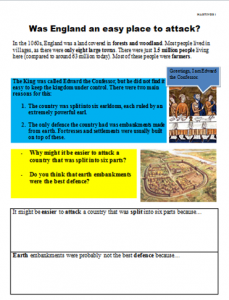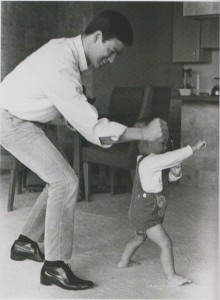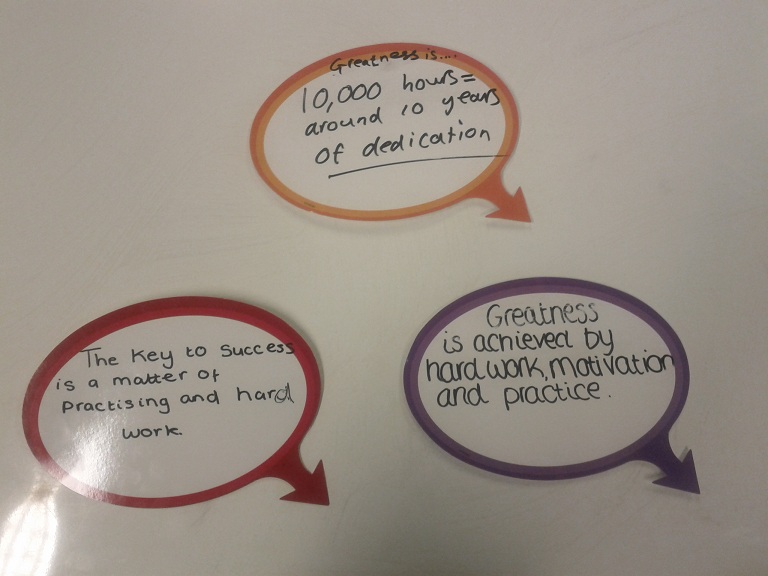Differentiation is hard.
It has proven to be the most stubborn and demanding issue I have tackled in my teaching career. I didn’t intend for my quest to fully differentiate a scheme of work to become an epic journey that Ulysses would be proud of, but it has.
Some would say that differentiation is easy. In fact, after deciding to concentrate on differentiation this year I attended a twilight session about differentiation and we were told that the keys to making it work were chunking, colour and images. I produced the following resource at the session:
There is nothing wrong with the resource in itself, but it did not get to the heart of the issue. The question I was still asking myself was ‘What I am differentiating for?’ This chunked and colourful sheet was helping students to access instructions and simplifying the content so that they could find a route into the topic, and although this is an important aspect of teaching, it did not lead to better outcomes. I was differentiating access and not for progress in History. I was still expecting students to somehow achieve the ‘next step’ on their own. Realising this set me off on the right path and enabled me to begin thinking about I could differentiate to help students truly progress in my classroom. To do this I needed to focus on writing in particular and how it was structured.
I don’t think that I am anywhere near a complete understanding, I do ,however, have three observations to share and offer for debate:
1. There is a social and emotional element to achievement in literacy that needs addressing before anything else. I am rapidly coming to the conclusion that this is best achieved by addressing oracy first.
2. Any progress in writing has to develop the ‘how’ as well as the ‘what.’ In other words, we need to teach students how writing works and not just what to write if they are to make real progress. Functional Grammar can help with this.
3. Differentiation and progression in writing has to be linked to the specific demands of writing within the subject. literacy on its own will not, for example, make students into better historians. That only happens if we start to unpick what writing looks like within our subject areas.
I will address each of these points in a separated blog post over the coming weeks. Firstly, I would like to address confident talk, why it is so important and the impact it has made on my classroom.
TALKING WITH CONFIDENCE
I have advocated talking as a vital way of preparing for writing for a while now (see this post on the TOWER model), but I wanted to do something more with it.
There is a need, I think, to boost the confidence of students with weak literacy and to demonstrate to them that they can be confident communicators. My hypothesis is that, in the first instance, confident talk would be easier to achieve than confident writing and that achievement in one area would lead to success in others. in other words, allowing students the chance to succeed in oracy would provide them with the confidence to tackle and eventually succeed in literacy.
I returned to my trusty and now battered copy of Ron Berger’s An Ethic of Excellence. In the introduction he says:
I believe that work of excellence is transformational. Once a student sees that he or she is capable of excellence, that student is never quite the same. There is a new self-image, a new notion of possibility. There is an appetite for excellence. After students have had a taste of excellence, they’re never quite satisfied with less; they’re always hungry.
If I could show students that they could become expert talkers then it would be easier to convince them that they could also become expert writers.
I was lucky to discover that Neil Mercer and his team at Cambridge University have been working on an Oracy Assessment Toolkit. This provides clear advice on how to help students peer and self assess their talk and makes a range of excellent resources free on their website. Although they outline several types of talk, I decided to focus, for now, on presentation talk. I set about adapting their framework so that I could use it to model and assess expert presentation skills in the classroom.
For a first run, I chose a Year 7 group that has a number of students with weak literacy. I introduced the idea of expert presenters to them by showing a clip of Hans Rosling giving a superb TED talk about washing machines:
As a class we then unpicked what made it such a skilful presentation. Having set the standard, I then set up an activity that would allow the whole class to demonstrate their skills as communicators. Armed with their criteria checklists and information, they began to create presentations about the Black Death. At this point, the activity was limited to discussing a single source for two minutes and I made sure that the focus was on communication as well as the quality of the historical understanding.
You can download the double-sided sheet here (Oracy Peer Assessment Grid Black Death) and the differentiated sheet here (Oracy Peer Assessment Grid DIFF Black Death).
As students were preparing, I moved around the room and offered advice and corrections on the History elements, checking that their analysis and claims were sound. I left the critique of the presentation elements to the rest of the class. When students were rehearsed, we held a public critique, with students giving each other constructive advice on how to improve the quality of their presentations. Students then went away and redrafted and polished their performance before they attempted it for a second time.
Allowing time to rehearse was essential so that all students have the opportunity to commit most of what they want to say to memory. I think that most of the advice on Teacher Talk given by Martin Robinson on his ‘Surreal Anarchy’ blog is just as applicable to students delivering their presentations. The aim is to make it sound and feel professional – giving students the chance to experience quality communication.
The results were better than I had hoped for. Given how unfamiliar speaking in front of the class was for some of these students, I was very encouraged by the quality that presentations, with students creating or bringing in props, using analogy (my favourite was ‘the Black Death was like sinister eagle, ready to swoop down from the sky’) and confidently giving opinions. I repeated the activity with my other Year 7 groups and tried the same technique with Year 9 when they were completing a piece of work about typicality. A similar pattern emerged, with students who had issues with their literacy showing greater levels of engagement, attention to detail and confidence.
The focus on excellence was, as Berger says, transformational. showing students that they can stand toe-to-toe with experts gives them a confidence and self-worth that become infectious.
This were the first attempts at something that will need to be used regularly and part of a sustained programme. However, I was more convinced than ever that a focus of excellence and he power of talking were key to unlocking the potential of students. The next step, of course, was how to transfer this into written work.
COMING SOON…
Differentiation Part Two: How To Improve Writing With A Little ‘Know How…’




